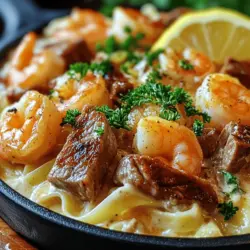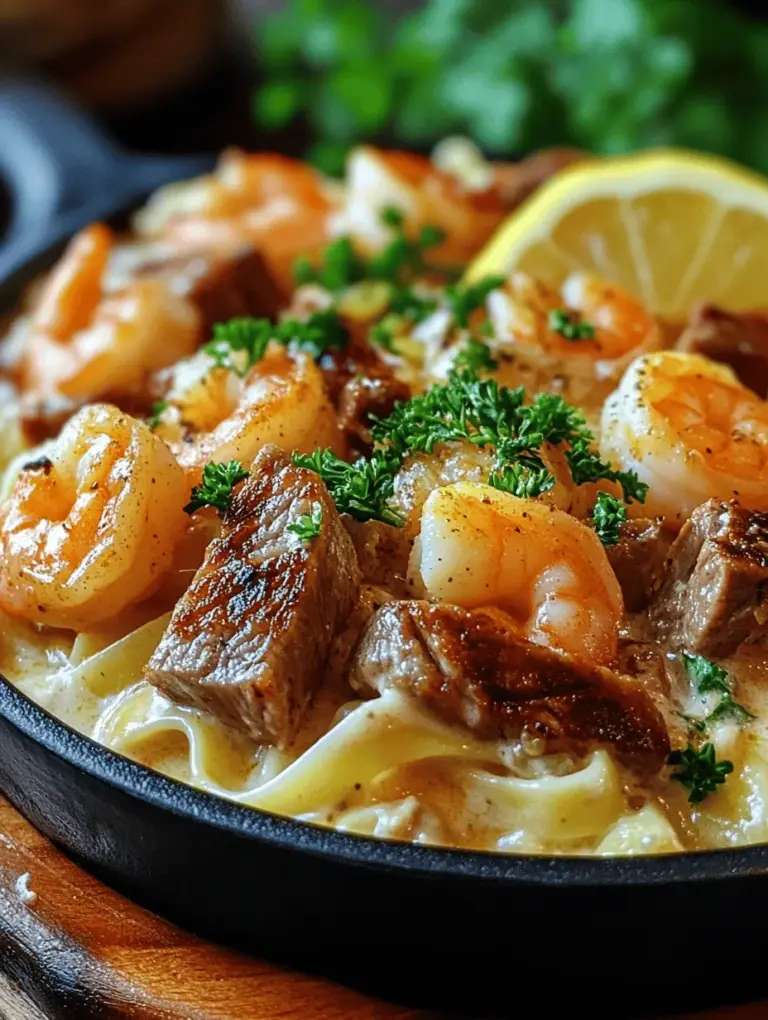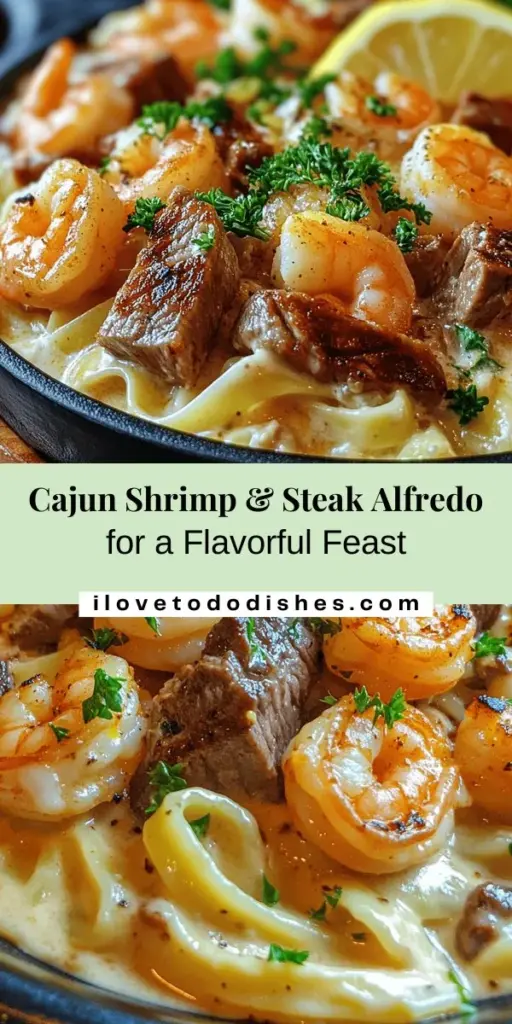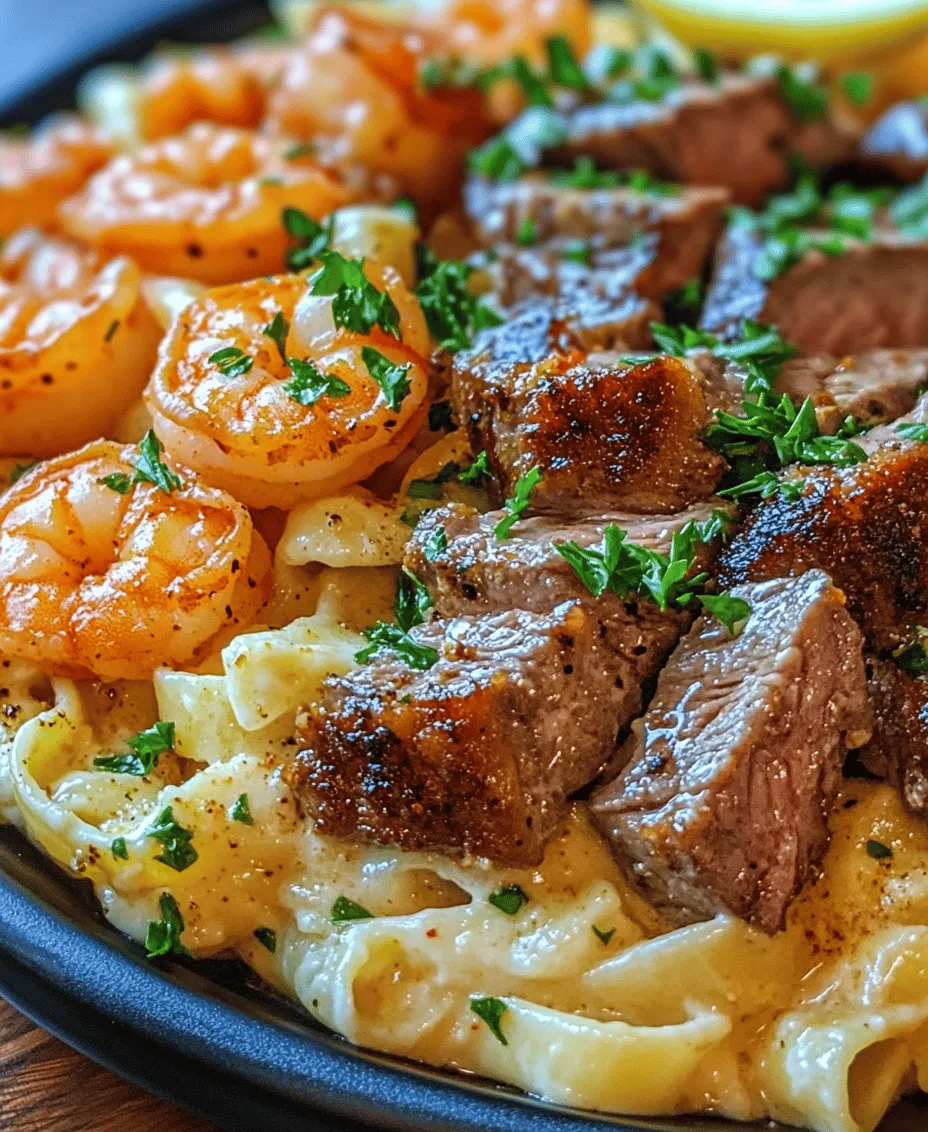Introduction
If you’re seeking a dish that tantalizes the taste buds while providing a comforting and indulgent experience, look no further than Cajun Shrimp & Steak Alfredo. This remarkable fusion marries the richness of creamy Alfredo sauce with the bold, zesty flavors of Cajun spices. The result is a hearty meal that perfectly balances the savory tastes of succulent shrimp and tender steak, all served over a bed of al dente fettuccine pasta. Whether you’re preparing a weeknight dinner or planning a special occasion, this dish is sure to impress.
Cajun cuisine, which originated in Louisiana, is known for its robust flavors and use of spices. By incorporating elements from this vibrant culinary tradition into a classic Italian dish like Alfredo, we create a unique and mouthwatering experience that celebrates both cultures. In this article, we will guide you through the essential steps needed to prepare Cajun Shrimp & Steak Alfredo, exploring the ingredients, cooking techniques, and tips that will elevate your dish to restaurant-quality perfection.
Understanding the Ingredients
Overview of Fettuccine Pasta
Fettuccine is a popular type of pasta that is characterized by its flat, thick strands. It serves as an ideal base for creamy sauces like Alfredo because its shape allows it to hold onto the sauce beautifully, ensuring every bite is as flavorful as the last. When selecting fettuccine for your dish, consider using fresh pasta if available, as it has a tender texture that enhances the overall experience. However, dried fettuccine is also a great option and is widely accessible.
The Importance of Fresh Shrimp
When it comes to seafood, freshness is key to achieving the best flavor and texture. For this recipe, opt for fresh shrimp that has been peeled and deveined. Look for shrimp that are firm to the touch and have a mild, ocean-like scent. If fresh shrimp isn’t available, frozen shrimp can be a convenient alternative. Just be sure to thaw them properly before cooking. Fresh shrimp adds a sweet, briny flavor that beautifully contrasts with the richness of the Alfredo sauce.
Choosing the Right Cut of Steak: Ribeye vs. Sirloin
The choice of steak can greatly influence the dish’s overall flavor profile. Ribeye and sirloin are two popular cuts that work well in Cajun Shrimp & Steak Alfredo. Ribeye is known for its marbling, which contributes to a juicy and flavorful bite. However, sirloin is a leaner option that still delivers great taste, making it a suitable choice for those seeking a healthier alternative. Regardless of which cut you choose, ensure that it is high-quality and well-marbled for the best results.
The Role of Cajun Seasoning in Flavor Development
Cajun seasoning is the heart and soul of this dish, imparting a distinct flavor that is both spicy and aromatic. Typically made from a blend of paprika, cayenne pepper, garlic powder, onion powder, thyme, and oregano, Cajun seasoning adds depth and warmth to the shrimp and steak. You can purchase pre-made Cajun seasoning or create your own custom blend to suit your taste preferences. Be cautious with the amount you use; the goal is to enhance the dish without overwhelming it.
The Creamy Base: Understanding Heavy Cream and Parmesan Cheese
The creamy Alfredo sauce is achieved through the careful combination of heavy cream and Parmesan cheese. Heavy cream adds a luscious thickness, while freshly grated Parmesan provides a nutty, salty flavor that elevates the sauce. When preparing the sauce, it is essential to use high-quality ingredients. Freshly grated cheese melts better than pre-packaged shredded cheese and contributes to a smoother sauce. Additionally, consider adding a touch of cream cheese for added richness.
Fresh Parsley: A Garnish that Elevates the Dish
While the flavors of Cajun Shrimp & Steak Alfredo are undoubtedly the stars of the show, fresh parsley serves as a delightful finishing touch. The vibrant green color adds visual appeal, while the mild herbal flavor complements the dish. Finely chop the parsley and sprinkle it over the plated dish just before serving to add a refreshing contrast to the rich sauce.
Enhancing Flavor with Garlic and Olive Oil
Garlic and olive oil are essential components of the preparation process that contribute to the overall flavor of Cajun Shrimp & Steak Alfredo. Sautéing minced garlic in olive oil before adding the shrimp and steak introduces a fragrant aroma and a subtle depth of flavor. Using high-quality extra virgin olive oil can enhance the dish’s taste profile, making each bite more enjoyable.
Preparation Process
Step-by-Step Guide to Making Cajun Shrimp & Steak Alfredo
Now that we’ve explored the key ingredients that make up this delicious dish, it’s time to dive into the preparation process. Here’s a step-by-step guide to crafting Cajun Shrimp & Steak Alfredo that will leave your guests raving about your culinary skills.
Cooking Perfect Fettuccine: Tips for Achieving Al Dente
To start, bring a large pot of salted water to a rolling boil. Salt not only adds flavor to the pasta but also helps to enhance the overall taste of the dish. Add the fettuccine and cook according to the package instructions, usually around 8-10 minutes. To achieve that perfect al dente texture, taste the pasta a minute or two before the suggested cooking time is up—it should be tender but still have a slight bite. Once cooked, reserve a cup of pasta water to help adjust the sauce’s consistency later if needed, then drain the pasta and set it aside.
Seasoning Techniques: How to Properly Coat Shrimp and Steak
While the pasta is cooking, it’s time to prepare the shrimp and steak. Begin by patting the shrimp dry with paper towels to ensure a good sear. In a small bowl, combine Cajun seasoning with a drizzle of olive oil to create a paste. Toss the shrimp in this mixture until they are evenly coated, allowing the flavors to infuse.
For the steak, season it generously with salt, pepper, and a sprinkle of Cajun seasoning on both sides. Allow the steak to sit for about 15-20 minutes at room temperature to develop flavor and ensure even cooking.
Searing Steak: Achieving the Ideal Doneness
Heat a large skillet over medium-high heat and add a tablespoon of olive oil. Once the oil is hot and shimmering, carefully place the steak in the skillet. Sear for 4-5 minutes on each side for medium-rare, adjusting the time based on your preferred level of doneness. Use a meat thermometer for precision; an internal temperature of 130-135°F is ideal for medium-rare. Once cooked to your liking, remove the steak from the skillet and allow it to rest on a cutting board for at least 5 minutes before slicing it into strips against the grain. This resting period ensures that the juices redistribute, resulting in a more tender and flavorful piece of meat.
Cooking Shrimp: Ensuring Optimal Texture and Flavor
In the same skillet, add a bit more olive oil if necessary, and increase the heat to high. Add the seasoned shrimp in a single layer, being careful not to overcrowd the pan. Cook for 2-3 minutes on one side until they turn pink and opaque. Flip the shrimp and cook for an additional minute or two until cooked through. Remove the shrimp from the skillet and set them aside, making sure not to overcook them as they can become rubbery.
Crafting the Alfredo Sauce: Balancing Creaminess and Flavor
With the shrimp and steak cooked, it’s time to make the Alfredo sauce. In the same skillet, reduce the heat to medium and add minced garlic. Sauté for about 30 seconds until fragrant, being careful not to burn it. Pour in the heavy cream and bring it to a gentle simmer, stirring frequently. Allow the cream to reduce slightly for a couple of minutes before adding in the freshly grated Parmesan cheese. Stir until the cheese melts and the sauce becomes creamy, adjusting the consistency with reserved pasta water if necessary. Season with additional salt, pepper, and Cajun seasoning to taste.
Combining Ingredients: Techniques for a Harmonious Blend
Once the Alfredo sauce is ready, add the cooked fettuccine, shrimp, and sliced steak to the skillet. Toss everything together gently, ensuring that the pasta is coated evenly with the sauce and that the shrimp and steak are distributed throughout. If the mixture appears too thick, add a splash of reserved pasta water to loosen it up. This step is crucial for ensuring every ingredient is well combined and that the flavors meld together beautifully.
Serving Suggestions
As you plate your Cajun Shrimp & Steak Alfredo, consider how to enhance the presentation. A large serving bowl or individual pasta dishes works wonderfully. Top each serving with a sprinkle of freshly chopped parsley and a little extra Parmesan cheese for added flavor and visual appeal. Pair this dish with a side of garlic bread or a fresh green salad to complete the meal. Enjoy the delightful flavors and comforting textures of this culinary adventure that brings the essence of Cajun cuisine right to your table.
In the next part of this article, we will dive into additional serving suggestions and tips for the best results to ensure your Cajun Shrimp & Steak Alfredo becomes a favorite among family and friends. Stay tuned for more insights into this delicious dish!
Plating Techniques for a Restaurant-Quality Presentation
Presentation plays a crucial role in elevating any dish, and Cajun Shrimp & Steak Alfredo is no exception. To achieve a restaurant-quality plate, consider the following techniques:
1. Choose the Right Plate: Opt for a large white or off-white plate to allow the vibrant colors of the dish to stand out. A contrasting color can make the dish pop and create an appealing visual.
2. Layering: Start with a base of Alfredo pasta, twirling it into a nest-like shape in the center of the plate. This creates height and dimension, making the dish more visually enticing.
3. Strategic Placement: Arrange the shrimp and steak on top of the pasta, ensuring they are evenly distributed. This not only looks appealing but also allows each bite to have a balanced combination of flavors.
4. Sauce Application: Drizzle some of the Alfredo sauce around the plate for an artistic flair. You can use a squeeze bottle for more precision, creating swooshes or dots that enhance the overall presentation.
5. Final Touches: Finish with a sprinkle of fresh herbs, such as parsley or chives, to add a pop of color. Consider adding a lemon wedge on the side for an extra touch of elegance.
The Role of Garnishes: Fresh Parsley and Lemon Wedges
Garnishes not only enhance the visual appeal of your dish but also add layers of flavor. Fresh parsley is a classic choice for Cajun Shrimp & Steak Alfredo. It offers a vibrant green contrast against the creamy sauce and provides a fresh, herbal note that complements the rich flavors of the dish.
Lemon wedges are equally essential; they provide a zesty brightness that can cut through the richness of the Alfredo sauce. Encourage diners to squeeze fresh lemon juice over their servings, adding a refreshing tang that enhances the overall flavor profile.
Suggested Side Dishes: Complementing Flavors and Textures
Pairing Cajun Shrimp & Steak Alfredo with the right side dishes can elevate the meal experience. Here are some suggestions that complement the dish’s flavors and textures:
1. Garlic Bread: A classic choice, garlic bread adds a crispy texture and robust flavor that pairs beautifully with the creaminess of the Alfredo sauce.
2. Caesar Salad: The crunchy romaine and creamy Caesar dressing provide a refreshing contrast to the rich pasta. The sharpness of the dressing can also balance the dish’s flavors.
3. Roasted Vegetables: Consider serving a medley of roasted seasonal vegetables such as zucchini, bell peppers, and asparagus. The natural sweetness and slight char from roasting enhance the overall dining experience.
4. Coleslaw: A tangy coleslaw can serve as a light, crunchy side that cuts through the richness of the Alfredo sauce, providing a refreshing palate cleanser.
Wine Pairing: Enhancing Your Meal Experience
Selecting the right wine can significantly enhance your dining experience. For Cajun Shrimp & Steak Alfredo, consider these pairing options:
– Chardonnay: A full-bodied Chardonnay with notes of butter and vanilla complements the creamy Alfredo sauce perfectly. Look for one that is lightly oaked for the best balance.
– Sauvignon Blanc: If you prefer a crisper wine, a Sauvignon Blanc offers bright acidity and citrus notes that can cut through the richness while enhancing the dish’s Cajun flavors.
– Red Wine: For those who prefer red, a light Pinot Noir can work well, as its fruitiness and acidity can balance both the steak and the creamy sauce without overpowering it.
Nutritional Insights
Understanding the Health Aspects of Cajun Shrimp & Steak Alfredo
While Cajun Shrimp & Steak Alfredo is undeniably delicious, it’s essential to consider its nutritional profile and how to enjoy it in a balanced way.
Nutritional Breakdown of the Main Ingredients
– Shrimp: A great source of lean protein, shrimp is low in calories and contains beneficial nutrients like selenium and vitamin B12. It’s also rich in omega-3 fatty acids, which are good for heart health.
– Steak: While higher in calories, steak provides important nutrients such as iron, zinc, and vitamin B12. Opt for leaner cuts, such as sirloin, to reduce fat content while still enjoying the rich flavors.
– Pasta: Traditional pasta is high in carbohydrates and can contribute to energy levels; however, it is advisable to consider portion sizes, especially if you are watching your calorie intake.
– Alfredo Sauce: Cream and cheese make Alfredo sauce rich in fat and calories. However, using a lighter cream or incorporating cauliflower for a healthier alternative can reduce calorie counts without sacrificing flavor.
Balancing Richness with Healthier Options
To create a lighter version of Cajun Shrimp & Steak Alfredo, consider the following modifications:
– Whole Wheat Pasta: Swap traditional pasta for whole wheat or legume-based pasta to increase fiber content and improve overall nutrition.
– Cauliflower Alfredo: Experiment with making a cauliflower-based Alfredo sauce, which uses blended steamed cauliflower instead of heavy cream. This alternative can significantly lower calories while maintaining a creamy texture.
– Vegetable Additions: Increase the vegetable content by adding spinach, bell peppers, or mushrooms to the dish, enhancing both the nutritional value and flavor profile.
Modifications for Dietary Preferences
For those with specific dietary preferences, Cajun Shrimp & Steak Alfredo can be easily modified:
– Gluten-Free: Use gluten-free pasta options made from rice, quinoa, or chickpeas to accommodate gluten sensitivities.
– Dairy-Free: Create a dairy-free Alfredo sauce using coconut milk or cashew cream, and ensure the cheese is replaced with a suitable dairy-free alternative.
– Low-Carb/Keto: For a low-carb version, use spiralized zucchini or shirataki noodles as a substitute for traditional pasta, allowing you to enjoy the dish without the carbs.
Cultural Background
Exploring the Origins of Cajun Cuisine
Cajun cuisine is a vibrant reflection of the rich cultural tapestry of Louisiana. It has roots in the French Acadian settlers who arrived in the region in the 18th century, bringing with them their culinary traditions. Over the years, these traditions blended with local ingredients, Native American influences, and African cooking techniques, resulting in a unique and flavorful cuisine.
The Influence of Cajun Culture on American Cooking
Cajun food has significantly influenced American cooking, particularly in the Southern United States. Dishes like gumbo, jambalaya, and etouffee showcase the use of spices, herbs, and local ingredients that characterize this cuisine. The bold flavors of Cajun cooking have not only captured the hearts of many but also inspired chefs across the nation to incorporate these elements into their menus.
Historical Context of Cajun Seasoning and Its Ingredients
Cajun seasoning, often characterized by its robust flavors, typically includes paprika, cayenne pepper, garlic powder, onion powder, and black pepper. These spices reflect the availability of ingredients in the region and the necessity for flavor in the often simple, rustic dishes of Cajun culture. The use of these seasoning blends is a testament to the creativity and resourcefulness of Cajun cooks, who transformed humble ingredients into flavorful meals.
The Evolution of Alfredo Sauce: From Italian Roots to American Adaptations
Alfredo sauce has its origins in Italy, where the classic fettuccine Alfredo was created by Alfredo di Lelio in the early 20th century. However, it wasn’t until the dish made its way to America that it underwent significant adaptations. The American version became richer, incorporating heavy cream and cheese, resulting in the creamy sauce we know today. This evolution reflects the blending of culinary traditions and the American inclination towards indulgence in comfort food.
Common Mistakes and Troubleshooting
Avoiding Pitfalls When Preparing Cajun Shrimp & Steak Alfredo
Creating the perfect Cajun Shrimp & Steak Alfredo requires attention to detail. Here are some common mistakes to avoid:
1. Overcooking the Pasta: One of the most frequent pitfalls is overcooking the pasta, leading to a mushy texture. Always cook the pasta al dente according to package instructions, tasting a minute or two before the recommended time to ensure it retains its bite.
2. Misjudging Seasoning: Striking the right balance between spicy and creamy can be challenging. Start with a small amount of Cajun seasoning and gradually add more to taste. Remember, you can always add more, but you cannot take away.
3. Ensuring Proper Cooking Times for Shrimp and Steak: Shrimp cooks quickly, usually taking only 2-3 minutes per side, while steak may require more time depending on the thickness and desired doneness. Use a meat thermometer to ensure the steak reaches a safe internal temperature without overcooking.
4. Overheating the Alfredo Sauce: Alfredo sauce can easily separate or become grainy if overheated. Gently reheat the sauce on low heat and stir continuously to maintain its creamy texture. Adding a splash of pasta water can help restore creaminess if it thickens too much.
Conclusion
Cajun Shrimp & Steak Alfredo is more than just a meal; it’s an experience that encapsulates the rich flavors of Cajun cuisine and the comforting essence of Italian pasta dishes. By following the detailed guidance provided, anyone can create a restaurant-quality dish in the comfort of their home, impressing family and friends alike. Whether it’s a weeknight dinner or a special occasion, this recipe is sure to satisfy and delight, offering a taste of the vibrant culinary traditions that influence American cooking today. Enjoy experimenting with flavors, presentations, and pairings to make this dish uniquely yours!



